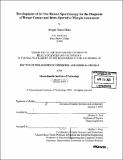| dc.contributor.advisor | Michael S. Feld. | en_US |
| dc.contributor.author | Haka, Abigail S | en_US |
| dc.contributor.other | Harvard University--MIT Division of Health Sciences and Technology. | en_US |
| dc.date.accessioned | 2008-02-28T16:08:26Z | |
| dc.date.available | 2008-02-28T16:08:26Z | |
| dc.date.copyright | 2005 | en_US |
| dc.date.issued | 2005 | en_US |
| dc.identifier.uri | http://dspace.mit.edu/handle/1721.1/30270 | en_US |
| dc.identifier.uri | http://hdl.handle.net/1721.1/30270 | |
| dc.description | Thesis (Ph. D.)--Harvard University--MIT Division of Health Sciences and Technology, 2005. | en_US |
| dc.description | Includes bibliographical references. | en_US |
| dc.description.abstract | Breast cancer is the most commonly diagnosed cancer among women in the United States. It is the most common cause of death in women ages 45-55. Optical techniques can potentially play a diagnostic role in several aspects of breast cancer evaluation and treatment. This thesis outlines progress on the use of Raman spectroscopy to diagnose breast cancer. Laboratory studies on fresh-frozen tissues are used to demonstrate that the detailed information provided by Raman spectroscopy yields accurate breast disease diagnosis. A Raman spectroscopic-based diagnostic algorithm was developed which classifies samples into four categories according to specific pathological diagnoses: normal, fibrocystic change, fibroadenoma, and infiltrating carcinoma. Cancerous lesions were separated from non- cancerous tissues with a sensitivity of 94% and a specificity of 95%. Further, use of a spectral model based on the morphological structures that comprise breast tissue allows increased understanding of the relationship between a Raman spectrum and tissue disease state. Based on the excellent results of our laboratory work, two clinical studies were undertaken. These studies translate Raman spectroscopy from a laboratory technique into a clinically useful tool. The first study tests the diagnostic algorithm in a prospective manner on freshly excised tissue. Preliminary results are promising. The second study is the first demonstration of in vivo data acquisition of Raman spectra of breast tissue. The culmination of this research is the demonstration of accurate intra-operative margin status assessment during partial mastectomy surgeries. | en_US |
| dc.description.abstract | (cont.) Application of our previously developed diagnostic algorithm resulted in perfect sensitivity and specificity in this small in vivo data set. These preliminary findings indicate that Raman spectroscopy has the potential to lessen the need for re-excision surgeries resulting from positive margins and thereby reduce the recurrence rate of breast cancer following partial mastectomy surgeries. The experiments and theory presented throughout this thesis demonstrate that Raman spectroscopy is a viable clinical tool that can be used to accurately diagnosis breast cancer and breast disease. | en_US |
| dc.description.statementofresponsibility | by Abigail Susan Haka. | en_US |
| dc.format.extent | 314 p. | en_US |
| dc.language.iso | eng | en_US |
| dc.publisher | Massachusetts Institute of Technology | en_US |
| dc.rights | M.I.T. theses are protected by copyright. They may be viewed from this source for any purpose, but reproduction or distribution in any format is prohibited without written permission. See provided URL for inquiries about permission. | en_US |
| dc.rights.uri | http://dspace.mit.edu/handle/1721.1/30270 | en_US |
| dc.rights.uri | http://dspace.mit.edu/handle/1721.1/7582 | |
| dc.subject | Harvard University--MIT Division of Health Sciences and Technology. | en_US |
| dc.title | Development of in vivo Raman spectroscopy for the diagnosis of breast cancer and intra-operative margin assessment | en_US |
| dc.type | Thesis | en_US |
| dc.description.degree | Ph.D. | en_US |
| dc.contributor.department | Harvard University--MIT Division of Health Sciences and Technology | |
| dc.identifier.oclc | 60847567 | en_US |
